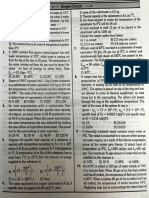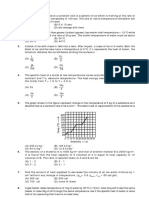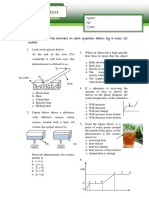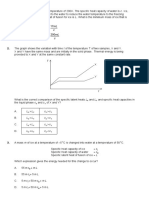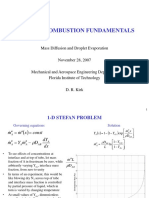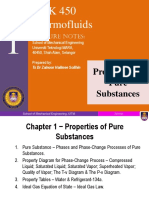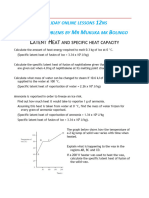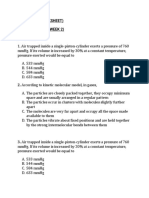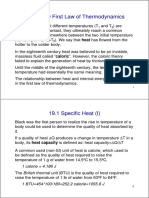Page 1 of 5 CPP - SANKALP_HT–3-PH-III
CPP
HEAT&THERMODYNAMICS - SHEET: 3
LEVEL – I
1. M kilograms of a material are to be kept in melted state at melting point and power required for this purpose is
P. When power source is disconnected then the sample completely solidifies in t sec. Find the latent heat of
fusion of the material.
2. A block of metal of mass 0.20kg is heated to 1500 C and dropped in copper calorimeter of water equivalent
0.025kg, containing 150g of water at 27o C. The final temperature is 40o C. Find the specific heat of the metal.
Given, specific heat of water 4.2 103 Jkg1K 1
3. Two solid objects of the same mass are supplied with heat at the same rate 1
Q/t. The temperature of the first object with latent heat L1 and specific heat
2
capacity c1 changes according to graph 1 on the diagram. The temperature of
Temperature
the second object with latent heat L2 and specific heat capacity c2 changes
according to graph 2 on the diagram. Based on what is shown on the graph, the
latent heats L1 and L2 and the specific heat capacities c1 and c2 in solid state
obey which of the following relationships.
(A) L1 L2; c1 c2 (B) L1 L2; c1 c2
(C) L2 L1; c1 c2 (D) L2 L1; c2 c1 Time
4. 2 kg water at 100C and 2.5 kg water at 50C is kept in two
identical containers A and B respectively of water equivalent 0.5
kg. If water of container A is placed poured into container B the
final temperature of mixture is T1 and if water of container B is
poured into container A the final temperature is T2. (heat loss is 100C 50C
negligible)
(A) T1 = T2 (B) T2 T1 = 5 A B
(C) T1 = 75C (D) T2 = 75
5. A quantity of heat required to change the unit mass of a solid substance, from solid state to liquid state, while
the temperature remains constant, is known as
(A) Latent heat (B) Sublimation (C) Hoar frost (D) Latent heat of fusion
6. How much heat energy is gained when 5 kg of water at 20oC is brought to its boiling point (Specific heat of
water = 4.2 kJ kg–1c–1)
(A) 1680 kJ (B) 1700 kJ (C) 1720 kJ (D) 1740 kJ
7. 80 gm of water at 30oC are poured on a large block of ice at 0oC. Take Lf =80 cal/gm. The mass of ice that
melts is
(A) 30 gm (B) 80 gm (C) 1600 gm (D) 150 gm
8. The thermal capacity of 40 gm of aluminum (specific heat = 0.2 cal/gm/ oC) is
(A) 40 cal/ oC (B) 160 cal/ oC (C) 200 cal/ oC (D) 8 cal/ oC
9. A lead ball moving with a velocity V strikes a wall and stops. If 50% of its energy is converted into heat, then
what will be the increase in temperature (Specific heat of lead is S Cal/Kg/K)
2V 2 V2 V2 V 2S
(A) (B) (C) (D)
JS 4JS J 2J
10. 2 kg of ice at –20C is mixed with 5 kg of water at 20C in an insulating vessel having a negligible heat
capacity. Calculate the final mass of water remaining in the container. It is given that the specific heats of
water and ice are 1 kcal/kg per C and 0.5 kcal/kg/C while the latent heat of fusion of ice is 80 kcal/kg
(A) 7 kg (B) 6 kg (C) 4 kg (D) 2 kg
11. Water of volume 2 litre in a container is heated with a coil of 1 kW at 27C. The lid of the container is open and
energy dissipates at rate of 160 J/s. In how much time temperature will rise from 27C to 77C [Given specific
heat of water is 4.2 kJ/kg/K]
(A) 8 min 20 s (B) 6 min 2 s (C) 7 min (D) 14 min
FIITJEE Ltd., ICES House, Sarvapriya Vihar (Near Hauz Khas Bus Terminal), New Delhi - 16, Ph : 6515949 , 6865182, 6854102, Fax : 6513942
�Page 2 of 5 CPP - SANKALP_HT–3-PH-III
12. A block of ice at –10C is slowly heated and converted to steam at 100C. Which of the following curves
represents the phenomenon qualitatively
(A) (B)
(C) (D)
13. Three liquids L1, L2 and L3 are at temperatures 30C, 20C and 10C respectively. When equal masses of L1
and L2 are mixed, temperature of the mixture is 26C when equal masses of L1 and L3 are mixed, the
temperature of the mixture is 15C. If equal masses of L2 and L3 are mixed, find the temperature of the
mixture.
(A) 11.8C (B) 13.5C
(C) 16.7C (D) 18C
14. The given figure shows three spheres X, Y and Z. These are of the same material and at same temperature.
X is a solid sphere of radius R, Y is an extremely thin-walled hollow sphere of radius R and sphere Z, also of
radius R, has a cavity of radius R/3, as shown. Match column-I and Column-II.
R
R R
R/3
X Y Z
Column-I Column-II
(A) If same amount of heat is given top each sphere, expansion of which (p) X
spheres will be different from each other?
(B) If the sphere are heated to a common temperature, expansion of which (q) Y
sphere will be the same?
(C) As the temperature is increased, spheres Z will expand but its cavity size. (r) Z
(D) For a given amount of heat supplied to each sphere, increase of temperature (s) Increases
will be the same for which spheres?
(t) None of the above
LEVEL – II
1. A heating curve has been plotted for a solid object as shown in the figure. If the Temp. (K)
mass of the object is 200 g, find latent heat of vaporization for the material of the 800
objects. [Power supplied to the object is constant and equal to 1 kW] 300
500 1200 1600 2500
Time (s)
2. A thermally insulated vessel contains some water at 0°C. The vessel is connected to a vacuum pump to pump
out water vapour. This results in some water getting frozen. It is given Latent heat of vaporization of water at
0°C = 21 × 105 J/kg and latent heat of freezing of water = 3.36 × 105 J/kg. Find the maximum percentage
amount of water that will be solidified in this manner.
3. A calorimeter of negligible heat capacity contains 100 g of water at unknown temperature. 30g of ice at
3
temperature 0 is put into calorimeter. Overall volume of ice and water mixture reduces by 2 cm when system
FIITJEE Ltd., ICES House, Sarvapriya Vihar (Near Hauz Khas Bus Terminal), New Delhi - 16, Ph : 6515949 , 6865182, 6854102, Fax : 6513942
�Page 3 of 5 CPP - SANKALP_HT–3-PH-III
comes in equilibrium. What is the initial temperature of water. [density of water w = 1 g/cc, density of ice i =
0.9g/cc,
Latent heat of fusion of ice
= 80)
specific heat capacity of water
4. A hollow sphere of mass M (in kg) and radius R (in m) is rotating with an angular frequency (in rad/sec). It
suddenly stops rotating and 75% of the K.E. is converted into heat energy. If s joule/kg-kelvin is the specific
heat of the material of the sphere, find the rise of temperature of the sphere.
5. 2 gms steam at 100° is mixed with 5 gm ice at – 40°C in an ideal calorimeter. Find the final temperature of the
system. (Given Lv = 500 cal/gm; Sice = 0.5 cal/gm°C, Sw = 1 cal/gm °C; Lf = 80 cal/gm) :
6. An ice cube of mass 0.1 kg at 00C is placed in an isolated container which is at 2270C. The specific heat S of
the container varies with temperature T according to the empirical relation S=A+BT, where A=100 cal/kg-K
and B = 2 x 10-2cal/kg-K2. If the final temperature of the container is 270C, find the mass of the container.
(Latent heat of fusion for water = 8 x 104 cal/Kg-K, Specific heat of water = 103 cal/Kg-K)
7. A child running a temperature of 101°F is given an antipyrin (i.e. a medicine that lowers fever) which causes
an increase in the rate of evaporation of sweat from his body. If the fever is brought down to 98°F in 20 min,
what is the average rate of extra evaporation caused, by the drug. Assume the evaporation mechanism to be
the only way by which heat is lost. The mass of the child is 30 kg. The specific heat of human body is
approximately the same as that of water, and latent heat of evaporation of water at that temperature is about
580 cal g–1.
8. The specific heat of a solid at low temperature varies according to the relation c = kT3 where k is constant.
The heat required to raise the temperature of a mass m of such a solid from T = 0K to T = 20 K is
(A) 2 104 mK (B) 4 104 mK
(C) 8 10 mK
4
(D) 16 104 mK
COMPREHENSION
Calorimeter is a cylindrical container made of copper (specific heat capacity 0.1 cal/g°C). The container is insulated so
that there is no heat loss. There is a stirrer to keep the temperature uniform and a thermometer to record the
temperatures. A calorimeter contains 400 gm of water at temperature 1 & 100 gm of ice at temperature 2 is added
into the calorimeter. Now answer the following questions. (Take sp. heat capacities of ice and water as 0.5 cal/g°C
and 1 cal/g°C. Latent heat of fusion of ice is 80 cal/g).
9. (i) If 1 is 40°C and 2 is 0°C then find the final temperature of the system. (Neglect heat capacities of
calorimeter).
(A) 11°C (B) 16°C (C) 20°C (D) 40°C
(ii) If 1 is 40°C and 2 is 0°C then find the final temperature of the system. The mass of calorimeter is 250
gm.
(A) 17.1°C (B) 16°C (C) 20°C (D) None of these
(iii) If 1 is 40°C and 2 is –40°C then find the final temperature of the system. The mass of calorimeter is 250
gm.
(A) 17.1°C (B) 16°C (C) 13.3°C (D) None of these
(iv) If 1 is 15°C and 2 is –40°C then find the final amount of water in the calorimeter. The mass of calorimeter
is 250 gm.
(A) 400 gm (B) 420 gm (C) 500 gm (D) 460 gm
FIITJEE Ltd., ICES House, Sarvapriya Vihar (Near Hauz Khas Bus Terminal), New Delhi - 16, Ph : 6515949 , 6865182, 6854102, Fax : 6513942
�Page 4 of 5 CPP - SANKALP_HT–3-PH-III
CPP
HEAT&THERMODYNAMICS - SHEET: 3
ANSWERS
LEVEL – I
Pt
1.
M
2. Mass of water m1 150g 0.15kg
Mass of metal m2 0.20kg
Water equivalent of calorimeter w 0.025kg
t1 270 C,t 2 1500 Ct 400 C,s1 4.2 103 Jkg1K 1
Heat gained by water and calorimeter m1 w s1 t t1
0.15 0.025 4.2 103 40 27 9.555 103 J
If s is the specific heat of metal,
Heat lost by metal m2 s t 2 t 0.20 s 150 40 22sJ
Equating (1) and (2) , we have
s 0.43 103 Jkg1K 1
3. A
4. B, C
2 C(100 T1 ) 3 C(T1 50)
T1 = 70C
2.5C(100 T2 ) 2.5C(T2 50)
T2 = 75
5. (D)
6. (A) Q = m.c. = 5 x (1000 x 4.2) x (100 - 20)
= 1680 x 103 J = 1680 kJ
7. (A) if m gm ice melts then
Heat lost = Heat gain
80 x 1 x (30-0) = m x 80 m = 30 gm
8. (D) Thermal capacity = mc = 40 x 0.2 = 8 cal/oC.
1 1 2 V2
W JQ mV J x mS
2 2
9. (B)
4JS
10. (B) Initially ice will absorb heat to raise it's temperature to 0C then it's melting takes place If mi = Initial mass
of ice, mi' = Mass of ice that melts and mw = Initial mass of water + Mass of ice that melts = 5 + 1 = 6 kg.
11. (A) Heat gained by the water = (Heat supplied by the coil) – (Heat dissipated to environment)
mc PCoil t PLoss t
2 4.2 103 (77 27) 1000 t 160 t
4.2 105
t 500 sec 8 min 20 sec .
840
12. (A) Initially, on heating temperature rises from –10C to 0C. Then ice melts and temperature does not rise.
After the whole ice has melted, temperature begins to rise until it reaches 100C. Then it becomes constant,
as at the boiling point will not rise.
13. A
heat lost = Heat gained
S 3
When L1 & L2 are mixed 1
S2 2
S1 1
When L1 & L2 are mixed
S2 3
S2 2
This gives
S3 9
14. (A—p. q. r) (B-p. q. r) (C-s(D-t)
FIITJEE Ltd., ICES House, Sarvapriya Vihar (Near Hauz Khas Bus Terminal), New Delhi - 16, Ph : 6515949 , 6865182, 6854102, Fax : 6513942
�Page 5 of 5 CPP - SANKALP_HT–3-PH-III
LEVEL - II
1. 4.5 106 J/kg
2. 86.2%
x + y = 100 …(1)
Heat lost = Heat gained
y × 3.36 × 105 = x × 21 × 105
y 21
=
x 3.36
336y = 21x × 100 …(2)
Using (1) & (2)
210000
y = = 86.21
2436
3. 14.4C
1 1
Reduction in volume = mass of ice melt
i w
10 x
2 = x 1 x = 18g
9 9
Only 18 g of ice melts means it is partial melting, thus final temperature is 0C. Let initial temperature of water
be . Heat lost by water = mSw = 100 Sw
Heat gained by ice = xLf = 18Lf
Heat lost by water = heat gained by ice.
R2 2
4.
4s
5. 100°C
Heat taken by ice to convert to water at 100°C fully :
5 ×(40) × (0.5) + 5 × 80 + 5 × (100) × (1) = 1000 cal.
Heat given by steam to condense fully :
2 × 500 = 1000 cal. Hence everything will be water at 100°C.
6. Heat received by ice is Q1 = mL + mCT = 10700 cal.
Heat lost by the container is Q2
500
500
BT 2
mC (A BT)dT mC AT = +21600 mC
300 2 300
By principle of calorimetry, Q1 = Q2
mC = 0.495 kg.
7. 0.129 gm/s
8. B
Integrate (mCdT) between 0K and 20 K.
9. (i) B, (ii) A, (iii) C, (iv) D
FIITJEE Ltd., ICES House, Sarvapriya Vihar (Near Hauz Khas Bus Terminal), New Delhi - 16, Ph : 6515949 , 6865182, 6854102, Fax : 6513942





